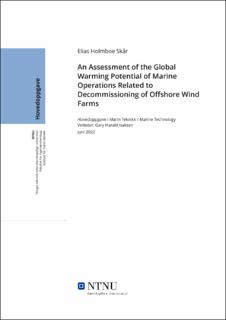| dc.description.abstract | Målet for denne oppgaven har vært å undersøke effekten av marine operasjoner knyttet til fjerning og avvikling av havvind. Studier som undersøker utslipp av drivhusgasser fra hele livssyklusen til havvindparker har blitt utført tidligere, men disse har fokusert på hele livssyklusen til havvind, og har ikke hatt et spesielt fokus hverken på marine operasjoner, eller sluttfasen av livssyklusen generelt.
I denne oppgaven har flere scenario og typer av havvindsparker blitt utviklet, for å identifisere hvilken del av avviklingsprossesen som påvirker miljøet mest. I tillegg har det blitt undersøkt hvilke metoder som kan brukes for å senke den eventuelle påvirkningen mest mulig. Et grunnscenario, som representer en gjennomsnittlig eller typisk moderne havvindspark har blitt utviklet, og består av 100 stykker 8 MW turbiner, montert på pålefundament. Denne havvindsparken ble brukt som sammenlikningsgrunnlag for å finne hvilke faktorer som påvirker miljøet mest. Effekten av forskjellige typer fundament, størrelsen og antallet turbiner, hvordan fjerning av kabler foregikk, og potensielle nye teknologier har på drivhusgassutslipp har blitt undersøkt.
Alle marine operasjoner knyttet til fjerning og avvikling av havvindsparker har blitt inkludert i undersøkelsen gjennomført i denne oppgaven. Det inkluderer forberedelser av havbunnen før fjerning av fundament, kutting og løft av fundament, demontering av vindturbiner, fjerning av kabler, og transport tilbake til land for videre demontering.
Resultatene viste at en typisk moderne havvindspark slipper ut 0.16 kg \ce{CO2}-ekvivalenter med drivhusgasser under avviklingen. Hva slags fundament som brukes hadde størst innvirkning på resultatene, fjerning av fagverksplattformer og gravitasjonsplatformer forurenset mer enn dobbelt så mye som fjerning av pålefundament. Men, resultatene viste også at det var mulig å redusere disse utslippene ved bruk av ny teknologi, og spesiallagde fartøy.
En undersøkelse av flytende havvind, en relativt ny utvikling, er også blitt gjennomført. Kun pilotprosjekter er blitt ferdigstilt så langt. Resultatene viser at for at avvikling av flytende anlegg skal kunne sammenliknes med bunnfaste anlegg, så må en større del av livssyklusen være med i undersøkelsen. | |
| dc.description.abstract | The world is in constant need for more energy, and at the same time, this energy needs to be produced with as little environmental impact as possible. Offshore wind power has been put forward as a solution to this dilemma, and the capacity of installed offshore wind power has exploded in the last decades. Of course, at some point, these wind farms will have reached the end of their life cycle, and will need to be powered down and removed.
The aim of this thesis has been to investigate the global warming potential of marine operations related to the decommissioning activities of offshore wind farm. Some work has been done on this previously, however, this has mostly been done in the form of life cycle assessments that have considered the entire life cycle, putting little focus on marine operations in general.
In this thesis, several wind farm cases and scenarios have been developed, in order to identify what part of the decommissioning process contributes the most to global warming, and what methods can be employed to potentially lower these contributions. A basecase, reflecting an "average" or typical modern offshore wind farm was established, consisting of 100 turbines with a rating of 8 MW installed on monopiles. This basecase was used as a basis for comparisons, in order to identify what affects greenhouse gas emissions the most. The effect types of foundations used in the wind farms, the size and number of turbines, how cables were removed, and new potential technologies have on greenhouse gas emissions have been assessed.
All marine operations related to the removal and decommissioning of an offshore wind farm was included in the assessment done in this thesis. Preparation of the seabed before foundation removal, the cutting and removal of the foundations, the disassembly of the wind turbines, the removal of cables, and the final transportation of all components back to shore.
The results show that for a typical modern offshore wind farm, the contribution to global warming from decommissioning activities is 0.16 kg \ce{CO2}-eq / MWh. The types of foundations that were used in the wind farm had the biggest effect on the environmental impact, with decommissioning of jacket and gravity based foundations contributing more than double to global warming, compared with decommissioning of monopile foundations. However, the results also showed that it was possible to significantly reduce the impact by utilizing new technologies and specialized vessels.
An assessment was also conducted on floating offshore wind farms, a relatively new development, with only pilot projects having been completed so far. However, the results show that this type of offshore wind farm, a larger part of the life cycle needs to be included in the assessment in order to achieve a result that is comparable to fixed offshore wind farms. | |
